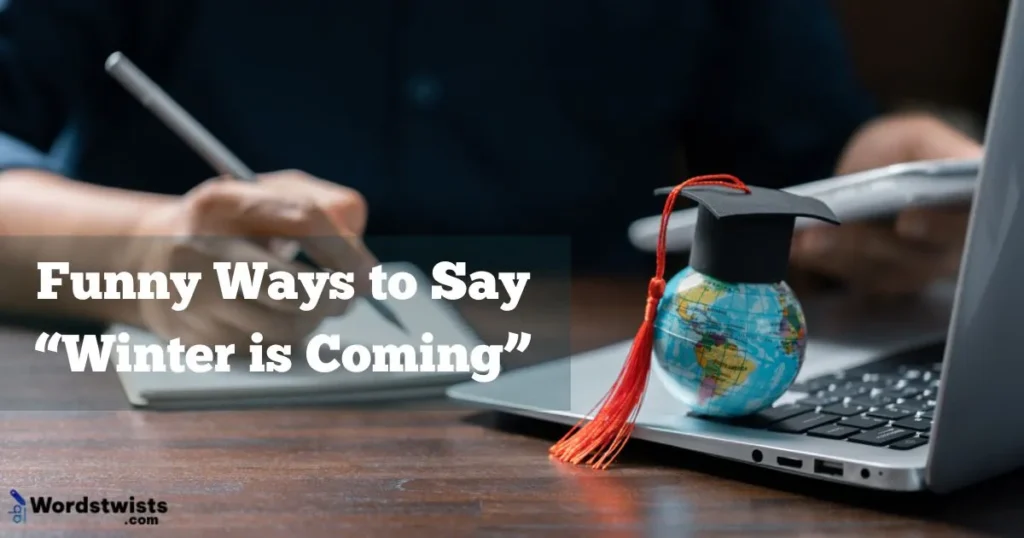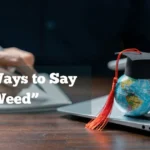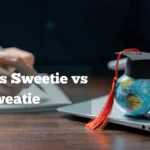Winter is creeping in, and if you’ve been overusing the phrase “funny way to say winter is coming,” you’re not alone. It gets repetitive, and it doesn’t always capture the chill, humor, or style you want. That’s why I’ve put together 25 unique alternatives. These phrases are playful, vivid, and memorable, helping your writing, captions, or speech stand out with personality.
Using these alternatives will make your words feel fresher, sharper, and more fun. You’ll bring humor, style, and clarity to your descriptions, impressing readers and friends alike. Let’s explore these creative ways to talk about winter.
Creative Alternatives to “Funny Ways to Say Winter is Coming”
1. Frosty Forecast Approaches
A playful way to hint at the coming cold. Perfect for casual writing, social media captions, or storytelling.
Usage Examples:
- Brace yourself, the frosty forecast approaches—time to dig out those wool socks.
- Coffee in hand, we watch the frosty forecast approaches over the city skyline.
- The frosty forecast approaches, so let’s plan a snowball fight!
- I love when the frosty forecast approaches; it makes sweater weather a reason to celebrate.
- Our weekend getaway just got interesting—the frosty forecast approaches!
Why it works: Combines humor and imagery, creating a vivid mental picture while keeping a light, playful tone.
2. Chill Is on Its Way
Simple, friendly, and direct. Works well for text messages, captions, or informal writing.
Usage Examples:
- Grab your scarves—the chill is on its way.
- I feel it in the air; the chill is on its way tonight.
- Time to sip hot cocoa; the chill is on its way.
- Everyone’s sweaters come out because the chill is on its way.
- The chill is on its way, and so is our winter mood.
Why it works: Gives a direct sensory cue, making readers feel the cold while keeping a conversational tone.
3. Winter Whispers
Poetic and magical. Great for storytelling, captions, or creative writing.
Usage Examples:
- Can you hear it? Winter whispers through the bare trees.
- The winter whispers promise cozy nights and warm blankets.
- I caught the winter whispers on my morning walk.
- Let’s follow the winter whispers to the snow-covered park.
- There’s magic in the air as winter whispers arrive.
Why it works: Makes winter feel alive and dynamic, engaging readers’ imagination and emotions.
4. Snow Sneaks In
Casual, fun, and playful. Perfect for captions or informal writing.
Usage Examples:
- Watch closely—the snow sneaks in overnight.
- The snow sneaks in, turning the city into a postcard.
- We woke up to see that the snow sneaks in quietly.
- Stay warm; the snow sneaks in without warning.
- Kids cheer as the snow sneaks in under the lamplight.
Why it works: Personifying snow adds movement and playfulness, making your words engaging.
5. Frost Is Creeping
Dramatic yet friendly, giving winter an active presence.
Usage Examples:
- Step carefully; the frost is creeping across the windows.
- The frost is creeping, covering every leaf in glitter.
- Our morning walk showed the frost is creeping quietly.
- Don’t forget the gloves; the frost is creeping tonight.
- The frost is creeping, hinting that winter is near.
Why it works: Personifying frost creates vivid imagery and draws readers in.
6. Cold Front Incoming
Meteorological but playful. Adds humor to updates or captions.
Usage Examples:
- Hold onto your hats—the cold front is incoming.
- Winter fashion check: the cold front is incoming.
- The cold front is incoming, bringing hot chocolate weather.
- Newsflash: the cold front is incoming, hide your plants!
- Evening strolls are better when the cold front is incoming.
Why it works: Combines a factual vibe with humor, making it informative yet lighthearted.
7. Frosty Fingers Arrive
Adds personality to winter, like it’s actively touching the world.
Usage Examples:
- Beware, the frosty fingers arrive to touch every windowpane.
- The frosty fingers arrive, making the streets sparkle.
- Kids notice when the frosty fingers arrive, signaling winter fun.
- Grab your mittens; the frosty fingers arrive tonight.
- The frosty fingers arrive, decorating every rooftop.
Why it works: Gives winter a playful, human-like quality, enhancing engagement.
8. Winter Marches In
Evokes strength and inevitability. Ideal for narrative or humorous writing.
Usage Examples:
- Bundle up; winter marches in like an unstoppable parade.
- The leaves fall quietly as winter marches in.
- Our morning walk felt brisk—winter marches in.
- The forecast warns: winter marches in this weekend.
- Time to light the fireplace; winter marches in.
Why it works: Personifies winter with purpose and presence, adding drama and humor.
9. Icy Breath Approaches
Creates a vivid sensory image with a hint of humor.
Usage Examples:
- Watch out—the icy breath approaches from the north.
- The icy breath approaches, chilling us to the bone.
- We hurried indoors; the icy breath approaches quickly.
- Even the trees shiver as icy breath approaches.
- Winter vibes are here; the icy breath approaches.
Why it works: Engages senses and imagination, making the description vivid and memorable.
10. Snowy Sneak Attack
Fun, casual, and playful. Great for captions or stories.
Usage Examples:
- Look outside—the snowy sneak attack has begun.
- Kids laughed as the snowy sneak attack covered the playground.
- Don’t be late; the snowy sneak attack might slow traffic.
- Get your camera ready—the snowy sneak attack is magical.
- Winter feels exciting with a snowy sneak attack.
Why it works: Adds humor and energy, making winter feel alive and mischievous.
Read More: Funny Ways to “Enjoy Coffee”
11. Winter Creeps Up
Simple, familiar, but still fresh with the right context.
Usage Examples:
- Stay warm; winter creeps up faster than expected.
- The mornings are colder as winter creeps up.
- The trees are bare; winter creeps up silently.
- We notice frost early as winter creeps up.
- Prepare your wardrobe—winter creeps up soon.
Why it works: Highlights the slow, inevitable arrival of winter, relatable for readers.
12. Frost Is Knocking
Gives winter a playful, personified presence.
Usage Examples:
- Time for hot drinks; frost is knocking tonight.
- The windows rattle lightly as frost is knocking.
- Prepare the fireplace; frost is knocking again.
- Our garden glimmers—the frost is knocking.
- Kids notice patterns in leaves as frost is knocking.
Why it works: Adds personality, making winter interactive and fun.
13. Chill Descends
A simple yet evocative way to describe cold arriving.
Usage Examples:
- Evening walk was brisk as chill descends.
- The mountain air feels sharper as chill descends.
- Our campsite prepared for when chill descends.
- Streets glimmer as chill descends overnight.
- Layer up; chill descends in the city tonight.
Why it works: Provides a clear visual and emotional cue, easy to relate to.
14. Winter Sneaks Close
Adds suspense and playfulness.
Usage Examples:
- Quiet streets show winter sneaks close.
- Morning frost hints that winter sneaks close.
- Time to finish gardening; winter sneaks close.
- Children notice snowflakes—winter sneaks close.
- Cozy evenings arrive as winter sneaks close.
Why it works: Builds anticipation, making winter feel dynamic.
15. Frost Lines Draw Near
Evokes imagery of frost spreading.
Usage Examples:
- Look at the windows; frost lines draw near.
- The park glitters as frost lines draw near.
- Early morning walks feel crisp—frost lines draw near.
- Winter crafts begin; frost lines draw near.
- Nature sparkles when frost lines draw near.
Why it works: Uses visual imagery, making winter engaging and aesthetic.
16. Icy Veil Approaches
Gives winter a dramatic, almost mysterious presence.
Usage Examples:
- Over the mountains, icy veil approaches.
- The lake freezes slowly as icy veil approaches.
- Morning fog hints that icy veil approaches.
- Prepare for frost; icy veil approaches tonight.
- Snowflakes glisten—icy veil approaches gracefully.
Why it works: Adds mystery and elegance, elevating simple winter imagery.
17. Cold Curtain Drops
Adds theatrical flair to the arrival of winter.
Usage Examples:
- Step inside; the cold curtain drops outside.
- The streets shine as cold curtain drops over the city.
- Hot drinks ready—the cold curtain drops tonight.
- Evening walks feel brisk; cold curtain drops.
- Nature sparkles when cold curtain drops.
Why it works: Makes winter feel like an event, engaging readers visually.
18. Winter Tiptoes In
Soft, friendly, and playful imagery.
Usage Examples:
- Quietly, winter tiptoes in among the trees.
- The frost is subtle as winter tiptoes in.
- Kids wake to see winter tiptoes in overnight.
- Layer up; winter tiptoes in slowly.
- Snowflakes sparkle as winter tiptoes in.
Why it works: Adds gentleness and charm, making winter relatable.
See Also: Funny Ways to Say “Drunk”
19. Frost Follows Close
Suggests a subtle, creeping cold.
Usage Examples:
- Every morning, frost follows close behind the dawn.
- Leaves glisten; frost follows close quietly.
- Prepare your garden; frost follows close.
- Winter walks are crisp as frost follows close.
- Even rooftops shimmer when frost follows close.
Why it works: Conveys a gradual, observable effect, connecting readers to nature.
20. Winter Shadows Stretch
Poetic, visual, and dramatic.
Usage Examples:
- Evening lights fade as winter shadows stretch.
- The frost glimmers—winter shadows stretch across the park.
- Trees stand tall while winter shadows stretch.
- Snow blankets quietly as winter shadows stretch.
- Cozy fires burn as winter shadows stretch over rooftops.
Why it works: Evokes visual storytelling, perfect for writing or captions.
21. Icy Fingers Reach
Personifies winter with playful imagery.
Usage Examples:
- Watch the windows—the icy fingers reach.
- Hot cocoa ready as icy fingers reach tonight.
- Streets sparkle when icy fingers reach over rooftops.
- Children notice snowflakes—the icy fingers reach.
- Nature glitters as icy fingers reach.
Why it works: Engages the imagination while keeping a friendly tone.
22. Snow Patrol Comes
Humorous and casual, perfect for captions.
Usage Examples:
- Get ready; snow patrol comes tonight.
- Kids cheer as snow patrol comes to the playground.
- Streets glimmer because snow patrol comes.
- Evening walk feels magical—snow patrol comes.
- Winter fashion check: snow patrol comes.
Why it works: Adds humor and personality, making winter approachable.
23. Frost Marches On
Strong, vivid, and slightly dramatic.
Usage Examples:
- The trees shiver as frost marches on.
- Streets glimmer; frost marches on silently.
- Evening winds hint that frost marches on.
- Nature sparkles while frost marches on.
- Kids watch carefully—frost marches on.
Why it works: Personification adds movement and drama, engaging readers visually.
24. Winter Tiptoes Near
Soft and playful, perfect for gentle winter imagery.
Usage Examples:
- Quietly, winter tiptoes near the hills.
- Frost glimmers as winter tiptoes near.
- Layer up; winter tiptoes near tonight.
- Children notice snowflakes—winter tiptoes near.
- Streets sparkle subtly; winter tiptoes near.
Why it works: Creates a gentle, charming mental image, friendly and approachable.
25. Icy Veins Spread
Dramatic, visual, and powerful.
Usage Examples:
- Across the lake, icy veins spread silently.
- Nature glistens as icy veins spread over rooftops.
- Streets sparkle; icy veins spread in the morning frost.
- Evening frost blankets—icy veins spread everywhere.
- Hot drinks ready; icy veins spread tonight.
Why it works: Adds drama, intensity, and visual detail, giving a unique twist on winter imagery.
Conclusion
Finding new ways to say “funny way to say winter is coming” doesn’t have to be hard—or boring. With these 25 creative alternatives, you can add humor, style, and personality to your writing or captions. Each phrase brings something unique—whether it’s playful, dramatic, poetic, or just plain fun—helping your words stand out and feel fresh.
Next time winter rolls around, try swapping the usual phrase for one of these alternatives. You’ll notice how much more engaging, lively, and memorable your sentences become. Have fun experimenting, and let your creativity shine with every snowy description!

I’m Leo Knox, the wordplay wizard behind WordsTwists.com where I turn everyday meanings into funny, clever, and creative twists. If you’re tired of saying things the boring way, I’ve got a better (and funnier) one for you!


